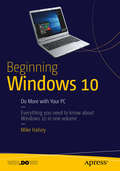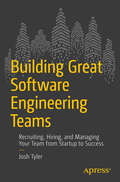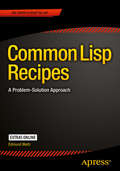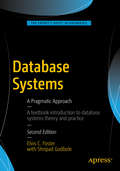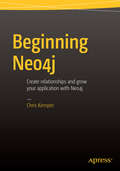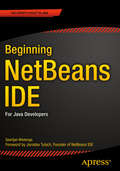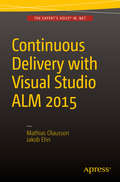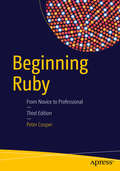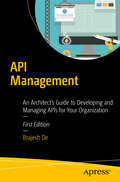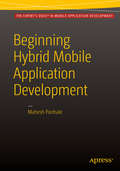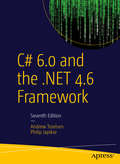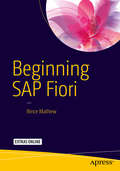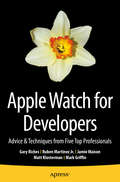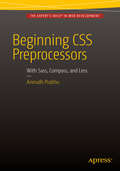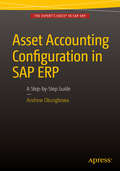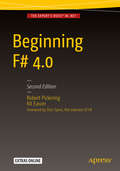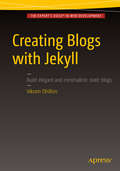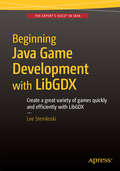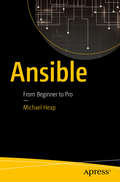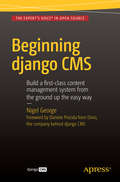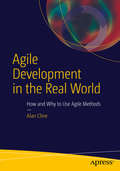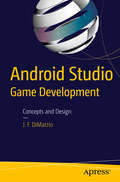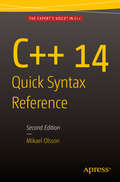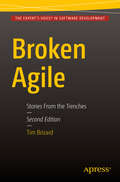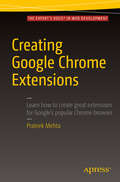- Table View
- List View
Beginning Windows 10: Do More with Your PC
by Mike HalseyBeginning Windows 10 takes you through the new features of this amazing new operating system, revealing some of its surprising capabilities, and helping you customize it to suit you. Whether you are new to Windows, or you want to get up to speed with the latest features and changes, this book has everything you need to get started. Author Mike Halsey shows you how to create an environment for school, work, and play that puts the important things at your fingertips, while combining them in ways you never thought possible. Learn how to carry your personalized Windows experience with you as part of your Microsoft account instead of having it tied to one device, while also keeping everything safe, secure and backed up, so you can enjoy peace of mind with your new PC. With the right start, your PC can become a tool that works for you, not against you, and leaves more of your time and energy free for the things that matter to you. Beginning Windows 10 shows you how. What you'll learn About the ins and outs of the Windows 10 interface and its new features How to personalize your Windows experience to give trouble-free performance How to manage your Microsoft account across different devices and services in the home, at work, and on the move How to maximize your productivity with Windows 10 How to secure and configure Windows 10 to guarantee a safe and secure experience How to use, hack and manipulate Windows to enable advanced customization Who this book is for Beginning Windows 10 is for people new to Windows or who want to get up to speed with the latest version. This book also can help people who already know how to perform routine tasks learn how to get more out of Windows, their computer and their time. Whether you want to get up and running with Windows 10, or want to go to the next level and learn useful ways to minimize problems, maximize performance, and optimize your overall Windows experience, this book is for you. Table of Contents Chapter 1: Introducing Windows 10 Chapter 2: Finding your Way Around Windows 10 Chapter 3: Connecting to Networks and the Internet Chapter 4: Sharing with Family and Friends Chapter 5: Organizing and Searching Your PC and the Internet Chapter 6: Managing Your Windows Ecosystem and Devices Chapter 7: Printing and Managing Printers Chapter 8: Having Fun with Games, Photos, Music, and Video Chapter 9: Maximizing Your Productivity Chapter 10: Personalizing Your Windows Experience Chapter 11: Making Windows 10 More Accessible and Easier to Use Chapter 12: Keeping Yourself, Your Files and Your Computer Safe Chapter 13: Maintaining and Backing up Your Computer and Files Chapter 14: Advanced Configuration and Customization Chapter 15: Getting Started with Virtualization Chapter 16: Installing Windows 10 on Your Computer Appendix A: Windows 10 Touch Gestures Appendix B: Windows 10 Shortcut Keys Appendix C: Advanced Query Syntax for Search Appendix D: Windows 10 Features by Edition Appendix E: Upgrading Your Computer
Building Great Software Engineering Teams: Recruiting, Hiring, and Managing Your Team from Startup to Success
by Josh TylerWINNER of Computing Reviews 20th Annual Best Review in the category Management “Tyler’s book is concise, reasonable, and full of interesting practices, including some curious ones you might consider adopting yourself if you become a software engineering manager.” —Fernando Berzal, CR, 10/23/2015 “Josh Tyler crafts a concise, no-nonsense, intensely focused guide for building the workhouse of Silicon Valley—the high-functioning software team.” —Gordon Rios, Summer Book Recommendations from the Smartest People We Know—Summer 2016Building Great Software Engineering Teams provides engineering leaders, startup founders, and CTOs concrete, industry-proven guidance and techniques for recruiting, hiring, and managing software engineers in a fast-paced, competitive environment.With so much at stake, the challenge of scaling up a team can be intimidating. Engineering leaders in growing companies of all sizes need to know how to find great candidates, create effective interviewing and hiring processes, bring out the best in people and their work, provide meaningful career development, learn to spot warning signs in their team, and manage their people for long-term success.Author Josh Tyler has spent nearly a decade building teams in high-growth startups, experimenting with every aspect of the task to see what works best. He draws on this experience to outline specific, detailed solutions augmented by instructive stories from his own experience. In this book you’ll learn how to build your team, starting with your first hire and continuing through the stages of development as you manage your team for growth and success. Organized to cover each step of the process in the order you’ll likely face them, and highlighted by stories of success and failure, it provides an easy-to-understand recipe for creating your high-powered engineering team.
Common Lisp Recipes: A Problem-Solution Approach
by Edmund WeitzFind solutions to problems and answers to questions you are likely to encounter when writing real-world applications in Common Lisp. This book covers areas as diverse as web programming, databases, graphical user interfaces, integration with other programming languages, multi-threading, and mobile devices as well as debugging techniques and optimization, to name just a few. Written by an author who has used Common Lisp in many successful commercial projects over more than a decade, Common Lisp Recipes is also the first Common Lisp book to tackle such advanced topics as environment access, logical pathnames, Gray streams, delivery of executables, pretty printing, setf expansions, or changing the syntax of Common Lisp. The book is organized around specific problems or questions each followed by ready-to-use example solutions and clear explanations of the concepts involved, plus pointers to alternatives and more information. Each recipe can be read independently of the others and thus the book will earn a special place on your bookshelf as a reference work you always want to have within reach. Common Lisp Recipes is aimed at programmers who are already familiar with Common Lisp to a certain extent but do not yet have the experience you typically only get from years of hacking in a specific computer language. It is written in a style that mixes hands-on no-frills pragmatism with precise information and prudent mentorship. If you feel attracted to Common Lisp's mix of breathtaking features and down-to-earth utilitarianism, you'll also like this book.
Database Systems: A Pragmatic Approach
by Elvis C. Foster Shripad GodboleDatabase Systems: A Pragmatic Approach is a classroom textbook for use by students who are learning about relational databases, and the professors who teach them. It discusses the database as an essential component of a software system, as well as a valuable, mission critical corporate resource. The book is based on lecture notes that have been tested and proven over several years, with outstanding results. It also exemplifies mastery of the technique of combining and balancing theory with practice, to give students their best chance at success. Upholding his aim for brevity, comprehensive coverage, and relevance, author Elvis C. Foster''s practical and methodical discussion style gets straight to the salient issues, and avoids unnecessary fluff as well as an overkill of theoretical calculations. The book discusses concepts, principles, design, implementation, and management issues of databases. Each chapter is organized systematically into brief, reader-friendly sections, with itemization of the important points to be remembered. It adopts a methodical and pragmatic approach to solving database systems problems. Diagrams and illustrations also sum up the salient points to enhance learning. Additionally, the book includes a number of Foster''s original methodologies that add clarity and creativity to the database modeling and design experience while making a novel contribution to the discipline. Everything combines to make Database Systems: A Pragmatic Approach an excellent textbook for students, and an excellent resource on theory for the practitioner. What you''ll learn Learn the relational model and the advantages it brings to software systems Design database schemas with integrity rules that ensure correctness of corporate data Query data using SQL in order to generate reports, charts, graphs, and other business results Learn what it means to be a database administrator, and why the profession is highly paid Become familiar with the common database brands, their similarities and distinctives Explore special topics such as tree-based data, hashing for fast access, distributed and object databases, and more Who this book is for Database Systems: A Pragmatic Approach is aimed at students who are studying database technology, who aspire to a career as a database administrator or designer. The book is particularly useful for professors teaching such students, and who are in need of an affordable textbook. Practicing database administrators and developers wanting to strengthen their theoretical grounding in their discipline may also find the book useful. Table of Contents Part I: Preliminary Topics 1. Introduction to Database Systems 2. The Database System Environment Part II: The Relational Database Model 3. The Relational Model 4. Integrity Rules and Normalization 5. Database Modeling and Design 6. Database User Interface Design 7. Relational Algebra 8. Relational Calculus 9. Relational System a Closer Look Part III: Structured Query Language 10. Overview of SQL 11. SQL Definition Statements 12. SQL Data Manipulation Statements 13. Logical Views and Security 14. The System Catalog 15. Some Limitations of SQL Part IV: Some Commonly Used DBMS Suites 16. Overview of Oracle 17. Overview of DB2 18. Overview of Microsoft SQL Server 19. Overview of Gupta Team Developer and MySQL 20. Overview of Borland Delphi Part V: Advanced Topics 21. Database Administration 22. Distributed Database Systems 23. Object Databases 24. Data Warehousing and Information Extraction 25. Web-Accessible Databases Part VI: Final Preparations 26. Sample Exercises and Examination Questions Part VII: Appendices A. Review of Trees B. Review of Hashing C. Review of Information Gathering Techniques
Beginning Neo4j
by Chris KemperThis book is your introduction in the world of graph databases, and the benefits they can bring to your applications. Neo4j is the most established graph database on the market, and it's always improving to bring more of its benefits to you. Beginning Neo4j will take you from the installation of Neo4j through to building a full application with Neo4j at its heart, and everything in between. Using this book, you'll get everything up and running, and then learn how to use Neo4j to build up recommendations, relationships, and calculate the shortest route between two locations. With example data models, and an application putting everything together, this book will give you everything you need to really get started with Neo4j. Neo4j is being used by social media and ecommerce industry giants. You can take advantage of Neo4j's powerful features and benefits - add Beginning Neo4j to your library today. What you'll learn Learn what Neo4j is and methods on how to install it Using Cypher, Neo4js query language to retrieve data Example data structures to help shape your application How to create relationships and recommendations between data Create an application that uses PHP and Neo4j together Taking your new Neo4j application into production Use Neo4j to calculate the shortest path between two locations Who this book is for This book is for anyone who wants to get started with graph databases, and doesn't know where to start. Table of Contents Chapter One: Introduction to Graph Databases Chapter Two: Getting to Know Neo4j Chapter Three: Get Up and Running with Neo4j Chapter Four: Meet Cypher Chapter Five: Managing Your Data in Neo4j Chapter Six: Importing and Exporting Data Chapter Seven: Using Data in Neo4j Chapter Eight: Building an App in Neo4j Chapter Nine: Neo4j in Production
Beginning NetBeans IDE: For Java Developers
by Geertjan WielengaBeginning NetBeans IDE is your authoritative guide for getting started learning and using the free and open source NetBeans IDE. Written by Geertjan Wielenga, who has worked on the NetBeans Team since 2004, it shows you what the IDE is all about and how to use it with real-world case studies built from the ground up as you learn all about the IDE. In this book, you get a tour of the various, essential, and key NetBeans features, including a range of wizards and plug-ins. Then, you start building a more complex Java EE-based application using Maven with the NetBeans IDE. And, you learn how to improve that application by exploring the NetBeans refactoring, testing, debugging, and profiling tools. After reading and using this guide, you'll come away with a working case study and many insights into how to understand and optimally make use of NetBeans IDE. What you'll learn What is NetBeans and how to use it How to install and set up your NetBeans IDE and environment How to write your first Java application using NetBeans How to explore the key NetBeans wizards and plug-ins How to build a complex Java EE-based application using Maven with NetBeans How to improve applications by refactoring, testing, debugging, and profiling Who this book is for This book is for those who are new to NetBeans who may have prior Java coding experience. Table of Contents 1. Installing and Setting Up 2. Getting Started 3. Java Editor 4. Using Wizards and Plugins 5. Putting the Pieces Together 6. Analysis and Refactoring 7. Testing and Code Quality 8. Debugging 9. Profiling and Tuning 10. Versioning
Continuous Delivery with Visual Studio ALM 2015
by Jakob Ehn Mathias OlaussonThis book is the authoritative source on implementing Continuous Delivery practices using Microsoft's Visual Studio and TFS 2015. Microsoft MVP authors Mathias Olausson and Jakob Ehn translate the theory behind this methodology and show step by step how to implement Continuous Delivery in a real world environment. Building good software is challenging. Building high-quality software on a tight schedule can be close to impossible. Continuous Delivery is an agile and iterative technique that enables developers to deliver solid, working software in every iteration. Continuous delivery practices help IT organizations reduce risk and potentially become as nimble, agile, and innovative as startups. What you'll learn What Continuous Delivery is and how to use it to create better software more efficiently using Visual Studio 2015 How to use Team Foundation Server 2015 and Visual Studio Online to plan, design and implement powerful and reliable deployment pipelines Detailed step by step instructions for implementing Continuous Delivery on a real project Who this book is for Developers, Release Engineers, Architects, Product Managers Table of Contents 1. Introduction to Continuous Delivery 2. Overview of Visual Studio ALM 2015 3. Designing an application for Continuous Delivery 4. Managing the Release Process 5. Source Control Management 6. PowerShell for Deployment 7. Build Automation 8. Managing Code Quality 9. Continuous Testing 10. Building a deployment pipeline 11. Measure and learn
Beginning Ruby: From Novice to Professional
by Peter CooperBased on the bestselling first edition, Beginning Ruby: From Novice to Professional, Second Edition is the leading guide for every type of reader who wants to learn Ruby from the ground up. The new edition of this book provides the same excellent introduction to Ruby as the first edition plus updates for the newest version of Ruby, including the addition of the Sinatra and Ramaze web application frameworks and a chapter on GUI development so developers can take advantage of these new trends. Beginning Ruby starts by explaining the principles behind object-oriented programming and within a few chapters builds toward creating a full Ruby application. By the end of the book, in addition to in-depth knowledge of Ruby, you'll also have basic understanding of many ancillary technologies such as SQL, XML, web frameworks, and networking. Introduces readers to the Ruby programming language Takes readers from basic programming skills to web development with topics like Ruby-based frameworks and GUI programming Covers many ancillary technologies in order to provide a broader picture (e. g. , databases, XML, network daemons) What you'll learn Understand the basics of Ruby and object-oriented building blocks. Work with Ruby libraries, gems, and documentation. Work with files and databases. Write and deploy Ruby applications. Explore Ruby web frameworks and aspects of network programming with Ruby. Develop desktop and GUI applications with Ruby. Who this book is for Beginning programmers, programmers new to Ruby, and web developers interested in knowing the foundations of the language. Table of Contents Let's Get It Started: Installing Ruby Programming = Joy: A Whistle-Stop Tour of Ruby and Object Orientation Ruby's Building Blocks: Data, Expressions, and Flow Control Developing Your First Ruby Application The Ruby Ecosystem Classes, Objects, and Modules Projects and Libraries Documentation, Error Handling, Debugging, and Testing Files and Databases Deploying Ruby Applications and Libraries Advanced Ruby Features Tying It Together: Developing a Larger Ruby Application Web Application Frameworks: Rails, Sinatra, and Ramaze Ruby and the Internet Networking, Sockets, and Daemons GUI-Based Desktop Application Development Useful Ruby Libraries and Gems
API Management: An Architect's Guide to Developing and Managing APIs for Your Organization
by Brajesh DeMaximize the impact of your assets and business services by providing APIs for developers and other users. The journey described in this book starts with identifying business assets. As part of the API team, you then need to identify and define the requirements of traffic management, security, mediation, and orchestration. You also must define metrics for the analytics to measure the success of the overall API program. API documentation and the ease of developer onboarding also determine the success of the APIs. Finally, monetization of these APIs leads to revenue generation for the enterprise. Author De -- an expert in building and managing API solutions -- provides enterprise architects, designers, and technologists with insight into the world of APIs and the various technical aspects of building and managing an effective API management solution. API Management: Developing and Managing APIs for your Organization: Introduces the basics of APIs and highlights their value Provides an overview of technologies for building an API management solution and defines the requirements, including how to build a RESTful API Offers design principles for building developer-friendly APIs Explains how to secure your APIs Shows how to use API analytics to measure the success of your APIs Demonstrates how to monetize APIs Finally, API Management touches on various technical nuances of creating, distributing, and managing an API. This book will not only help you learn how to design, build, deploy, and manage an API for an enterprise scale, but also generate revenue for your organization. What You'll Learn Discover the API life cycle Design and develop APIs Implement API security Test your APIs Deploy and monitor your APIs Who This Book Is For Enterprise architects, technology enthusiasts, security architects, and operations specialists.
Beginning Hybrid Mobile Application Development
by Mahesh PanhaleToday, a mobile device user prefers installed application over browsing internet; e. g. booking cab, buying movie tickets, watching you tube videos etc. Market share of mobile devices based on android, iOS & Windows Phone is considerable. Creating an installable application targeting these multiple devices involves too much of pain because of expertise required e. g. Java for android, Objective C for iOS and DotNET for Windows Phone. Shortcomings of this development approach are - more development time, it requires different expertise & involves less reusability of the code. A solution to this problem is HTML 5, JQuery, CSS 3 based - Hybrid Mobile Applications . These hybrid applications needs to be created once but after packaging can be deployed on multiple mobile devices like Android, iOS & Windows Phone. This kind of application development has edge over native application development. Beginning Hybrid Mobile Application Development by Panhale can help each entity involved in mobile application development. With availability of multiple coding and packaging platforms; HMAD has even become more easy. Since HMAD happens in HTML & Javascript it's even possible that with small effort conditionally; existing web application can be converted into mobile based application. HMAD can give larger audience for many web applications by making it available as mobile application. This book covers: Basics of Hybrid Application Development Platforms, Frameworks used for Hybrid Application Development Internals of how hybrid applications work Hybrid Application Development using available APIs Accessing data in hybrid application Role of JSON over XML in hybrid application Code Security This book will change the paradigm of mobile application development as the efforts are less, learning curve is small, success ratio is high and monetary benefit is on higher side! What you'll learn How to create, package, test & deploy hybrid mobile application step by step How to solve issues while accessing device specific features How to establish synergy between web application & mobile application Insight to advertisement frameworks in hybrid applications How to secure code in hybrid application Who this book is for Mobile application developers for Android, iOS, Windows Phone architects, and technical managers. Table of Contents Introduction to Mobile Application Development (MAD) Getting Started Building blocks of HMAD Creating first Hybrid Application HMAD: Internals Data Access in HMAD UI for HMAD Using device specific features in HMAD How to advertise with HMAD Working with third party services in HMAD Setup and Deployment XAMARIN vs HMAD! Case Study: Practical Approach
C# 6.0 and the .NET 4.6 Framework
by Philip Japikse Andrew TroelsenThis new 7th edition of Pro C# 6. 0 and the . NET 4. 6 Platform has been completely revised and rewritten to reflect the latest changes to the C# language specification and new advances in the . NET Framework. You'll find new chapters covering all the important new features that make . NET 4. 6 the most comprehensive release yet, including: A Refined ADO. NET Entity Framework Programming Model Numerous IDE and MVVM Enhancements for WPF Desktop Development Numerous updates to the ASP. NET Web APIs This comes on top of award winning coverage of core C# features, both old and new, that have made the previous editions of this book so popular. Readers will gain a solid foundation of object-oriented development techniques, attributes and reflection, generics and collections as well as numerous advanced topics not found in other texts (such as CIL opcodes and emitting dynamic assemblies). The mission of this book is to provide you with a comprehensive foundation in the C# programming language and the core aspects of the . NET platform plus overviews of technologies built on top of C# and . NET (ADO. NET and Entity Framework, Windows Communication Foundation (WCF), Windows Presentation Foundation (WPF), ASP. NET (WebForms, MVC, WebAPI). ). Once you digest the information presented in these chapters, you'll be in a perfect position to apply this knowledge to your specific programming assignments, and you'll be well equipped to explore the . NET universe on your own terms. What You Will Learn: Be the first to understand the . NET 4. 6 platform and C# 6. Discover the ins and outs of the leading . NET technology. Learn from an award-winning author who has been teaching the . NET world since version 1. 0. Find complete coverage of XAML, . NET 4. 6 and Visual Studio 2015 together with discussion of the new Windows Runtime.
Beginning SAP Fiori
by Bince MathewTake a deep dive into SAP Fiori and discover Fiori architecture, Fiori landscape installation, Fiori standard applications, Fiori Launchpad configuration, tools for developing Fiori applications and extending standard Fiori applications. You will learn: Fiori architecture and its applications Setting up a Fiori landscape and Fiori Launchpad Configuring, customizing and enhancing standard Fiori applications Developing Fiori native applications for mobile Internet of Things-based custom Fiori applications with the HANA cloud platform Bince Mathew, a SAP mobility expert working for an MNC in Germany, shows you how SAP Fiori, based on HTML5 technology, addresses the most widely and frequently used SAP transactions like purchase order approvals, sales order creation, information lookup, and self-service tasks. This set of HTML5 apps provides a very simple and accessible experience across desktops, tablets, and smartphones. What you'll learn Prerequisites and steps for setting up a Fiori landscape and Launchpad Fiori standard application configuration Extending and customizing standard Fiori applications Developing custom Fiori applications from scratch Building custom Fiori applications for Internet Of Things using HANA cloud Fiori apps with Cordova and Kapsel plugins Who this book is for Application developers Mobile application developers UX designers IT professionals Solution consultants Table of Contents Chapter 1: Introduction to SAP Fiori Chapter 2: Prerequisites and steps for setting up a Fiori landscape Chapter 3: Fiori Applications Chapter 4: Customizing and Extending Standard Fiori Applications Chapter 5: Fiori OData customization and Netweaver Gateway Overview Chapter 6: Fiori Custom Application development Tools Chapter 7: Introduction to HANA Smart Business Apps on FIORI Chapter 8: Debugging And Trouble Shooting Fiori Applications Chapter 9: Developing Fiori applications using Cordova and Kapsel plugins
Apple Watch for Developers: Advice & Techniques from Five Top Professionals
by Mark Griffin Gary Riches Ruben Martinez Jamie Maison Matt KlostermanApple Watch for Developers: Advice & Techniques from 5 Top Professionals gives you the base-knowledge and valuable secrets you'll need for your own projects from a core team of successful, experienced Apple Watch app-development experts. You'll explore elements such as branding within Watch apps, translating audio data into visual information, taming complex data, mastering environment-driven feature sets, and much more. This book is for developers who already have some knowledge of developing with WatchKit and WatchOS 2, and who are now interested in learning how to use them to create cutting edge Watch apps. It is written by five experienced, industry-leading Apple Watch developers who have created their apps early, and are now ready to pull apart examples to show you how to best create an Apple Watch app. This book will bring your cool Watch ideas to life! What you'll learn * Accept and handle voice recognition on the Apple Watch * Best send data back and forth from iCloud * Perform functions that take very few taps of a screen * Leverage frequency detection * Run your apps natively on the Watch * Work with App Groups to send and receive data * Interface with synced Twitter accounts Who this book is for â-- Apple Watch developers â-- Mobile developers (primarily iOS) Table of Contents Chapter 1: An Apple Watch Introduction Chapter 2: Examining the Stopwatch, Timer and Calendar Chapter 3: Taming Complex Data for the Watch Chapter 4: Examining Home Remote and its Components Chapter 5: Developing Notation - Audio to Musical Score Chapter 6: Building the Infi nitweet Application Chapter 7: Developing Apple Watch Cross-Platform Apps
Beginning CSS Preprocessors: With SASS, Compass.js and Less.js
by Anirudh PrabhuLearn how preprocessors can make CSS scalable and easy to maintain. You'll see how to write code in a very clean and scalable manner and use CSS preprocessor features such as variables and looping, which are missing in CSS natively. Reading Beginning CSS Preprocessors will make your life much simpler by showing you how to create reusable chunks of code. In addition to coding enhancements, you'll also learn to automate processes such as generating image sprites and minifying code. Beginning CSS Preprocessors is your guide for getting started with CSS preprocessors. This book shows you how to use CSS in your day-to-day work and thus be smart and efficient at writing CSS. What you'll learn What are preprocessors What are the known preprocessor frameworks What are the features of Sass (Syntactically Awesome Stylesheets) What is Compass (COMPrehensive ASSembler) What is Less (Leaner SS) Who this book is for UI developers who are well acquainted with CSS and want to make their workflow better. Table of Contents Chapter 1: Introduction to Preprocessors Chapter 2: Introduction to SASS Chapter 3: Advanced SASS Chapter 4: Development with Less Chapter 5: Introduction to Compass
Asset Accounting Configuration in SAP ERP: A Step-by-Step Guide
by Andrew OkungbowaIn this book, noted expert Andrew Okungbowa explains SAP Asset Accounting (FI-AA) in SAP-ERP, including its associated business benefits, and guides you through the considerable complexities of SAP-ERP configuration. Using FI-AA for fixed asset management enables you to manage assets in multinational companies across a broad range of industries and produce reports to meet various needs in line with legal requirements. Configuring SAP-ERP can be a daunting exercise, however, and there are few resources that address these issues. Asset Accounting Configuration in SAP ERP fills that resource gap by covering the major aspects of SAP FI-AA for anyone with SAP experience and the basic accounting knowledge and bookkeeping skills necessary to apply configuration. It provides configuration explanations in the simplest forms possible and provides step-by-step guidance with illustrations and practical examples. What you'll learn The details of the FI-AA syllabus How to configure FI-AA accounting in SAP How to integrate FI-AA accounting with other SAP modules How to transfer asset data How to prepare for startup and perform periodic processing Who this book is for The key target audience for this book includes SAP consultants, developers, accountants, support organizations and beginners. It is also a resourceful learning manual for universities and institutions whose curricula covers SAP-ERP Asset Accounting. Table of Contents Chapter 1 - Customizing Organizational Structures in SAP Asset Accounting (FI-AA) Chapter 2 - Integrating Asset Accounting with the General Ledger (FI-GL) Chapter 3 - Valuation of Fixed Assets Chapter 4 - Depreciation Chapter 5 - Special Valuation Chapter 6 - Customizing Master Data Chapter 7 - Customizing Transactions Chapter 8 - Customizing Validation and Substitution Chapter 9 - Reporting with Asset Accounting Chapter 10 - Transferring Asset Data Chapter 11 - Preparing for Production Startup Chapter 12 - Processing Periodic Programs Appendix A - Useful General Ledger Accounts Appendix B - Useful Transaction Codes
Beginning F# 4.0
by Robert Pickering Kit EasonThis book is a great foundation for exploring functional-first programming and its role in the future of application development. The best-selling introduction to F#, now thoroughly updated to version 4. 0, will help you learn the language and explore its new features. F# 4. 0 is a mature, open source, cross-platform, functional-first programming language which empowers users and organizations to tackle complex computing problems with simple, maintainable and robust code. F# is also a fully supported language in Visual Studio and Xamarin Studio. Other tools supporting F# development include Emacs, MonoDevelop, Atom, Visual Studio Code, Sublime Text, and Vim. Beginning F#4. 0 has been thoroughly updated to help you explore the new features of the language including: Type Providers Constructors as first-class functions Simplified use of mutable values Support for high-dimensional arrays Slicing syntax support for F# lists Reviewed by Don Syme, the chief architect of F# at Microsoft Research, Beginning F#4. 0 is a great foundation for exploring functional programming and its role in the future of application development. What you'll learn A deep familiarity with the tenets and advantages of functional programming. How to understand F# 4. 0's concise and elegant syntax. How to develop for real-world scenarios using functional programming and F# 4. 0. How to develop realistic applications through a comprehensive tutorial-based approach. How to learn imperative and concurrent programming techniques within the functional programming paradigm. Who this book is for Beginning F# 4. 0 is for anyone interested in state-of-the-art programming for solving real-world problems. It serves as an excellent introduction to F# for programmers of all backgrounds including C#, Java and VB as well as for lovers of Python, Ruby and other dynamic languages. If you are already familiar with functional programming, you'll find Beginning F#4. 0 a great introduction to the language itself. If you are new to the function programming arena, this book will also serve as a superb reference to FP in general and F# specifically.
Creating Blogs with Jekyll
by Vikram DhillonLearn to create your own blog using the Jekyll static site generator. You'll start with a simple template, add new features to it, automate any maintenance, attach social sharing, and begin writing. By the end of Creating Blogs with Jekyll, you will be able to create custom blogs with Jekyll, update the content with ease, and reach out to your readers with minimal effort. Because you've built your blog yourself, you'll know exactly how each component works, and you won't be dependent on an admin panel to maintain it. Creating Blogs with Jekyll equips you with the knowledge to create an elegantly designed blog and scale it to capture more readers. Recapture the magic of writing by creating great content and use an easy workflow in Jekyll to maintain it for blogging. Do new things and write about them in style with Jekyll. Takes you through building a fully functional blog from scratch using Jekyll Provides a fun way to work on a side-project and integrate cutting edge web technologies Teaches you how to update and maintain your awesome blog Jekyll is a simple, secure and very low maintenance blog engine that converts naturally written content in markdown into a beautiful and minimal blog. It allows you to focus on content creation and expressing yourself instead of spending all your time updating the plugins and maintaining the database. Jekyll does not rely on a database as a backend so your blog will be far more secure and reliable than any traditional blogging engines such as WordPress. We live in a day and age where short attention spans make it very difficult to expose a reader to interesting content. What better way to capture a reader's attention and retain viewers by captivating them by your own unique style and taste? Jekyll allows the content to shine with minimal distractions and a greater focus on the content and easy sharing of the content. What you'll learn Choose a base theme appropriate for your style and development Integrate various web technologies that will work well together and enhance your blog Automate social sharing components and comments workflow Make adjustments to themes, views and styles of blog posts Update any of the modular components of the blog and integrate new technologies Implementing Jekyll and deploying static websites for future projects Who this book is for Creating Blogs with Jekyll is for the developer who is ready to move beyond the complexities of maintaining a content management system by creating their own unique blog in their own style. It's for the project manager tired of spending all their time editing their blog on the admin panel and updating the content management system. Creating Blogs with Jekyll is an excellent choice for new developers to start blogging because of the simplicity of Jekyll's theming layer and writing workflow. It's an excellent choice for the web developer wanting to build their blog from scratch and expand their knowledge of higher level web technologies.
Beginning Java Game Development with LibGDX
by Lee StemkoskiDesign and create video games using Java, with the LibGDX software library. By reading Beginning Java Game Development with LibGDX, you will learn how to design video game programs and how to build them in Java. You will be able to create your own 2D games, using various hardware for input (keyboard/mouse, gamepad controllers, or touchscreen), and create executable versions of your games. The LibGDX library facilitates the game development process by providing pre-built functionality for common tasks. It is a free, open source library that includes full cross-platform compatibility, so programs written using this library can be compiled to run on desktop computers (Windows/MacOS), web browsers, and smartphones/tablets (both Android and iOS). Beginning Java Game Development with LibGDX teaches by example with many game case study projects that you will build throughout the book. This ensures that you will see all of the APIs that are encountered in the book in action and learn to incorporate them into your own projects. The book also focuses on teaching core Java programming concepts and applying them to game development. What you'll learn How to use the LibGDX framework to create a host of 2D arcade game case studies How to compile your game to run on multiple platforms, such as iOS, Android, Windows, and MacOS How to incorporate different control schemes, such as touchscreen, gamepad, and keyboard Who this book is for You should have an introductory level knowledge of basic Java programming. In particular, you should be familiar with: variables, conditional statements, loops, and be able to write methods and classes to accomplish simple tasks. This background is equivalent to having taken a first-semester college course in Java programming. Examples of intermediate-level Java topics that you will learn from this book include: data structures (lists, iterators, and dictionaries), exception handling, abstract classes, inner classes, and event-driven programming. You will also see software engineering practices in context, such as code refactoring, iterative development, and the creation of debugging features. Table of Contents 1. Getting Started with Java and LibGDX 2. Using the LibGDX Framework 3. Extending the LibGDX Framework 4. Audio and Resource Management 5. Advanced UI Design 6. Alternative Forms of Input 7. Integrating Third-Party Software 8. Introduction to 3D Programming 9. Taking Your Games Further Appendix A: Summary of Java Concepts Needed for This Book
Ansible: From Beginner to Pro
by Michael HeapThis book is your concise guide to Ansible, the simple way to automate apps and IT infrastructure. In less than 250 pages, this book takes you from knowing nothing about configuration management to understanding how to use Ansible in a professional setting. You will learn how to create an Ansible playbook to automatically set up an environment, ready to install an open source project. You'll extract common tasks into roles that you can reuse across all your projects, and build your infrastructure on top of existing open source roles and modules that are available for you to use. You will learn to build your own modules to perform actions specific to your business. By the end you will create an entire cluster of virtualized machines, all of which have your applications and all their dependencies installed automatically. Finally, you'll test your Ansible playbooks. Ansible can do as much or as little as you want it to. Ansible: From Beginner to Pro will teach you the key skills you need to be an Ansible professional. You'll be writing roles and modules and creating entire environments without human intervention in no time at all - add it to your library today. What You Will Learn Learn why Ansible is so popular and how to download and install it Create a playbook that automatically downloads and installs a popular open source project Use open source roles to complete common tasks, and write your own specific to your business Extend Ansible by writing your own modules Test your infrastructure using Test Kitchen and ServerSpec Who This Book Is For Developers that currently create development and production environments by hand. If you find yourself running apt-get install regularly, this book is for you. Ansible adds reproducibility and saves you time all at once. Ansible: From Beginner to Pro is great for any developer wanting to enhance their skillset and learn new tools.
Beginning django CMS
by Nigel GeorgeBuild a world-class website in less than a week with Django CMS. Beginning Django CMS shows you how to simply and easily write a dynamic website with a full content management system in the backend. It is written for Internet developers who are sick and tired of dealing with complicated, bloated website frameworks that are a pain to build and a nightmare to maintain. Django CMS is an Open Source website building framework that is experiencing exponential growth because it is built on the simple, secure and scalable architecture of Django. This book takes you from knowing nothing about Django CMS, to building a functional website and content management system that you can deploy for your own website or for your customers. What you'll learn How to build a dynamic website quickly and easily How to author and submit content for publication How to administer Django CMS How to install and use custom and third-party plugins How to deploy a website using Django CMS Who this book is for Programmers, in particular Python and Django programmers, wishing to build a simple, custom content management system (CMS). They do not have to be directly interested in the Django CMS application, Beginning Django CMS will be equally useful to a programmer looking to build a functioning CMS rapidly. Table of Contents 1. Working With a CMS 2. Installing Django CMS 3. Introduction to Django CMS 4. Site Templates 5. Your Blog Website: Templates 6. Django CMS: Plugins 7. Advances Plugins 8. Authoring in Django CMS 9. Menus and Navigation 10. Extending Django CMS 11. Next Steps
Agile Development in the Real World
by Alan ClineThis book is a practical guide for new agile practitioners and contains everything a new project manager needs to know to get up to speed with agile practices quickly and sort out the hype and dogma of pseudo-agile practices. The author lays out the general guidelines for running an agile project with the assumption that the project team may be working in a traditional environment (using the waterfall model, or something similar). Agile Development in the Real World conveys valuable insights to multiple audiences: For new-to-agile project managers, this book provides a distinctive approach that Alan Cline has used with great success, while showing the decision points and perspectives as the agile project moves forward from one step to the next. This allows new agile project managers or agile coaches to choose between the benefits of agile and the benefits of other methods. For the agile technical team member, this book contains templates and sample project artifacts to assist in learning agile techniques and to be used as exemplars for the new practitioner''s own project. For the Project Management Office (PMO), the first three chapters focus on portfolio management. They explain, for the agilists'' benefit, how projects are selected and approved, and why projects have an inherent "shelf-life" that results in hard deadlines that may seem arbitrary to traditional technical teams. What you''ll learn How and why the evolution of project management, from PM-1 (prescriptive) to PM-2 (adaptive) affects modern 21st century project management. How sociology (stakeholder management), psychology (team dynamics), and anthropology (organizational culture) affect the way software is developed today, and why it is far more effective A clear delineation of what must to be accomplished by all the roles (PM, BA, APM, Developer, and Tester), why those roles are needed, and what they must do Step-by-step guide for a successful project based on studies and the author''s own experiences. Specific techniques for each role on the development team, both in the pre-iteration and iteration cycles, of product development. The appendices contain templates that the team could use or modify to tailor their own agile processes specific to the team, project, and organization. Who this book is for This book is intended for project managers, technical team members and technical managers. It makes clear what agile is, and what agile is not and how Agile contributes significant business value. Table of Contents Chapter 1. Evolution of Project Management Chapter 2. Birth of a Project: Portfolio Management Chapter 3. Project Startup Chapter 4. Iteration Zero: Preparing the Project Chapter 5. Architecture: Product Foundation Chapter 6. Infrastructure: Supporting the Project Chapter 7. Initial Requirements: Defining the Product Chapter 8. Overview of an Agile Iteration Chapter 9. Requirements: The Agile Business Analyst Chapter 10. Development Thread Chapter 11. Testing Thread Outline Chapter 12. Project Management Thread Outline
Android Studio Game Development: Concepts and Design
by J. F. DimarzioThis short book walks you through the process of creating mobile games using the new Android Studio IDE. Android Studio Game Development introduces you to the key tools in Android Studio and gives you the knowledge you need to develop games in Android Studio.This book takes you from installing Android Studio, through exploring the IDE to creating a new project and setting up GitHub as a VCS. You'll then be well equipped to tackle the game-development topics that make up the rest of the book. You'll learn about OpenGL ES and how to deal with polygons, before mastering image loading and sprite sheets.The final three chapters cover topics vital to successful game development: interactivity. You'll gain skills in reading user input, responding to that input with in-game movement, and detecting collisions.You'll learn: How to create projects in Android Studio How to use the SDK manager to keep your Android SDK current How to commit to and get projects from GitHub How to use OpenGL ES to load images How to react to player input How to debug your games using Android Studio Audience This book is for those who may be new to game development who have some experience with Android Studio IDE and Android. To learn about Android Studio, check out Learn Android Studio IDE by Gerber and Craig (Apress).
C++ 14 Quick Syntax Reference: Second Edition
by Mikael OlssonThis updated handy quick C++ 14 guide is a condensed code and syntax reference based on the newly updated C++ 14 release of the popular programming language. It presents the essential C++ syntax in a well-organized format that can be used as a handy reference. You won't find any technical jargon, bloated samples, drawn out history lessons, or witty stories in this book. What you will find is a language reference that is concise, to the point and highly accessible. The book is packed with useful information and is a must-have for any C++ programmer. In the C++ 14 Quick Syntax Reference, Second Edition, you will find a concise reference to the C++ 14 language syntax. It has short, simple, and focused code examples. This book includes a well laid out table of contents and a comprehensive index allowing for easy review. What you'll learn How to create a C++ HelloWorld How to compile and run What are C++ variables, operators, pointers and references What are arrays, strings, conditionals, loops and more How to write functions How to work with constructors, inheritance, overridings How to use access levels, static, enum, string and union, and more What are custom conversions, namespaces, constants, and preprocessors How to do event handling What are type conversions, templates, headers, and more Who this book is for This book is a quick, handy pocket syntax reference for experienced C++ programmers, and a concise, easily-digested introduction for other programmers new to C++. Table of Contents 1. HelloWorld 2. Compile and Run 3. Variables 4. Operators 5. Pointers 6. References 7. Arrays 8. String 9. Conditionals 10. Loops 11. Functions 12. Class 13. Constructor 14. Inheritance 15. Overriding 16. Access Levels 17. Static 18. Enum 19. String and Union 20. Operator Overloading 21. Custom Conversions 22. Namespaces 23. Constants 24. Preprocessor 25. Event Handling 26. Type Conversions 27. Templates 28. Headers
Broken Agile: Second Edition
by Tim BrizardLearn how to be successful in adopting Agile and see good and bad examples of how Agile can be adopted. Broken Agile, Second Edition contains stories from years of real world experience on Agile teams and projects. The stories in each chapter are both educational and entertaining. Each chapter focuses on specific Agile values and principles. The stories in each chapter are used to illustrate how Agile values and principles are sometimes misunderstood or misapplied on Agile teams and projects. You will read how Agile is used in the real world and the consequences of poor adaptations of the Agile software development methodology. These stories will help you in your journey to adopt Agile software development. What you'll learn What are good and bad examples of how Agile can be adopted What are some specific Agile values and principles How some of these are misunderstood or misapplied How Agile is used in the real world What are the consequences of poor adoption of the Agile software methodology How some companies have been successful in adopting Agile Who this book is for This book is for experienced software developers in their journey to adopt Agile Software development. It is very useful for those considering implementation of Agile processes. Table of Contents 1. Introduction 2. Scale Success 3. Communication 4. Poor Foundations 5. Long Run Plan for Success 6. Adjusting in Time 7. Sending the Wrong Signals 8. Balancing Life and Work 9. Fake It Until You Make It 10. Building Unity 11. Keeping Engaged 12. Fundamental Mis-Understandings 13. Challenges with Estimations 14. Transparency 15. Specifications and Testing 16. Some Process Required 17. Physical vs. Virtual 18. Final Thoughts
Creating Google Chrome Extensions
by Prateek MehtaTransform your existing web applications into Google Chrome browser extensions and create brand new extensions that improve your own browsing experience and that of your users. This book shows you how Google Chrome browser extensions are extremely useful tools for enhancing the functionality of the Google Chrome web browser. For example, you can create extensions to summarize the current page you are reading, or to save all of the images in the page you are browsing. They have access to almost all of the features provided by the Google Chrome browser, and they can encapsulate such features in the form of a bundled application providing targeted functionality to users. Extensions also run in a sandboxed environment, making them secure - which is a huge plus in the modern web! The APIs provided by the Chrome Extensions framework help you empower web applications by coupling them with amazing features provided by the Google Chrome web browser, such as bookmarks, history, tabs, actions, storage, notifications, search, and a lot more - facilitating increased productivity on the Google Chrome web browser. What you'll learn Transform your web application ideas into Google Chrome extensions Choose the recommended components for creating your kind of extension Leverage the power of a Google Chrome browser by making use of the extensions API Showcase your existing web-development skills in a modern way by creating useful extensions. Who this book is for Creating Google Chrome Extensions is for existing web developers, experienced in creating simple web pages (using HTML, CSS, and JavaScript), to help them create browser extensions for Google Chrome. After understanding the examples and lessons in this book, you will be able to transform your existing web applications into Google Chrome browser extensions, as well as create brand new extensions.
